wsl
Windows Subsystem for Linux
wsl
Windows Subsystem for Linux
About wsl
Windows Subsystem for Linux (WSL) is a compatibility layer that runs on the Windows 10 operating system. It allows you to run Linux command-line tools directly on Windows 10 and access files from both the Linux and Windows file systems.
setup
The Windows Subsystem for Linux is a technology that enables you to run Linux binaries on Windows. It is not an emulation, nor does it provide a virtual machine. Setting it up needs a little understanding of Powershell.
install
Install a Linux distribution such as (Ubuntu, OpenSUSE, Kali, Debian, Arch Linux, and more) using the Windows Subsystem for Linux. WSL enables you to use Linux tools, like Bash or Grep, completely integrated with Windows tools, like PowerShell or Visual Studio code.
python
python
#1
Python is a programming language that is easy to learn. It is one of the most popular languages for beginners because it is simple, versatile, and powerful. The best thing about Python is that it does not require any complex setup. You can use it with your current operating system and development environment without any other requirements.
#2
Python has a large library of modules that you can use to accomplish most tasks. You do not need to install these modules separately, they are already installed in the standard Python installation.
#3
It has an interactive interpreter which allows you to run the code and see the results as you type them in, this makes it easier to debug errors and experiment with different code snippets without having to write a complete program or script first.
vim
vim
What is VIM? Vim is a terminal-based text editor that is extremely helpful for Unix and Linux. The first encounter with ‘vi’ was bizarre because it was confusing to me that I could open a program that I couldn’t close. Learning [:q] made me realize that this text editor is special. Its successor ‘vim’ is my favorite by now because it can be customized to the finest details that suit me and my needs. Getting comfortable with Linux distros forced me to use and learn the terminal text editor ‘vim,’ which I had wanted to learn for a long time.
Using Debian Linux distorts we can install it with:
sudo apt install vim
To run vim just write ‘vim’ in your terminal.






